-
Daejeon Medical Tourism
-
Medical Information
-
Tourist information
-
Community
-
Information Use
Tourist information
Attractions of Daejeon
Attractions of Daejeon
-
 Jangtaesan Mountain Forest
Jangtaesan Mountain Forest- 461, Jangan-ro, Seo-gu, Daedjeon
- 042-270-7883
- It is in Jangan-dong, Seo-gu, Daejeon and is one of the 12 Attractions of Daejeon with its magnificent landscape. The only Metasequoia forest in Korea is formed here densely and with its exotic landscape, and it is famous as a resting forest for families to enjoy. Jangtaesan Mountain Forest is the first forest developed and run by a private fund in South Korea. It was taken over by Daejeon Metropolitan City in February of 2002 and remodeled and re-opened in April, 2006.
-
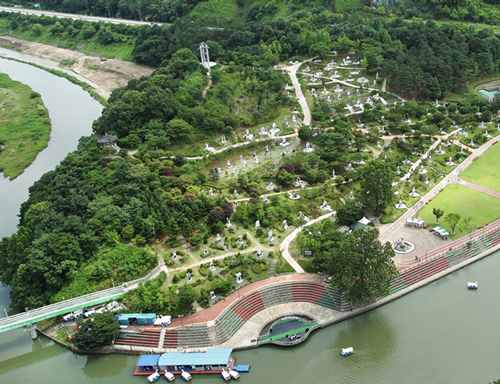 Ppuri Park
Ppuri Park- 70, Sajeonggongwon-r0, Jung-gu
- 042-228-8310
- Ppuri Park is an educational place with the world’s first sculptures symbolizing family names allowing everyone to know their background and foster filial piety and make them aware that they are from Korean descent. This park features a variety of facilities including sculptures of family names, Sasindo (the painting of four gods) and Sibijiji (the twelve terrestrial branches)-shaped spring water, waterside stage, where various events are held, the forest park, observatory, octagonal pavilion, recreational forest and the nature observation garden. In addition, there are 30 mini motor cars (2 seats, for preschoolers and elementary school students), a Traffic Safety Education Center, where traffic signs and pedestrian traffic lights are installed, nature observation trail and the arboretum. This park attracts visitors with a variety of cultural events: a family name sculpture installation and unveiling ceremony, provincial friendship tournament, children’s day event, senior citizens’ event, sign language singing park, music concert, etc., and fascinating facilities: Octagonal pavilion ‘Jasanjeong,’ chestnut tree park, pleasant trail, waterside stage, fountain, etc.
-
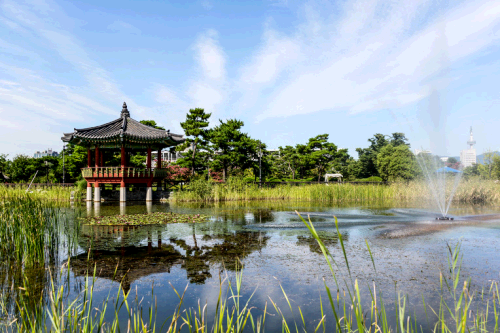 Hanbat Arboretum
Hanbat Arboretum- 169, Dunsan, Seo-gu, Daedjeon
- 042-270-8452
- The arboretum located near the Government Complex, Daejeon EXPO Science Park. The area is a mecca of arts and culture with the Daejeon Art Center, Pyeongsong Youth Cultural Center, City Art Museum, and the Lee Eungno Gallery which harmonize with and culture. Hanbat Arboretum in the city center is the largest man-made arboretum in Korea that connects the greens of the Daejeon Government Complex and the EXPO Science Park. It provides preservation of various plant species, educational space for youth, and a relaxing green area for citizens in the middle of the city. It consists of Seowon (West Garden, North of the City Art Museum) and Dongwon (East Garden, North of Pyeongsong Youth Cultural Center), which includes 19 theme gardens (Nammun [South Gate] Square, Magnolia Garden, Herb Garden, Rock Garden, Fruit Tree Garden, etc.), and Tropical Botanical Garden.
-
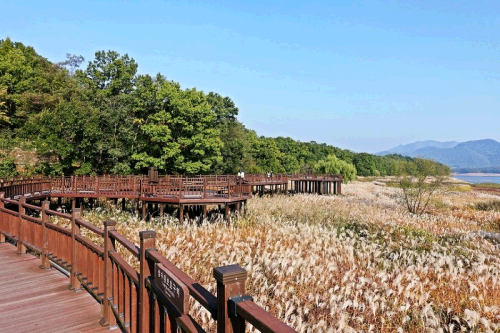 Daecheong Hoban Trail
Daecheong Hoban Trail- # 618-136, Daedeok-gu, Daejeon
- 042-270-5582
- Daecheong Lake was developed in 1980 when the Daecheong Dam was completed and has been providing drinking water, living water and industrial water to Daejeon city and Cheongju City since then. It is known for its driving route with small mountains at an altitude of 200-300 meter and beautiful shrubs extending above the lake. It is home of migratory birds and resident birds, and in summer, white herons are easily seen at the upper part of the lake. At the observatory, the visitors can view a magnificent landscape. The Water Promotion hall opened in 1998 has a 3D image hall and an aquarium. There is a lawn square as well. Around Daecheong Lake, there are other tourist attractions such as Geumgang River Park, Gangge Tourist Attraction and Munyi Cultural Site, which makes it easier to coordinate. To get to Daecheong Lake, take Kyungbu Highway and enter the Shintanjin Interchange. At the Shintanjin 4-way crossing, take the road leading to the Daecheong Dam. It takes about 3 hours to drive around the lake.
-
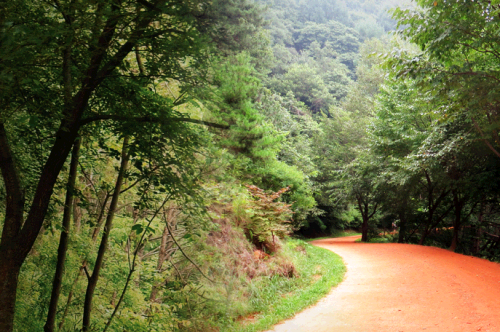 Gyejoksan Hwangtogil Trail
Gyejoksan Hwangtogil Trail- 79-70, Sandi-ro, Daedeok-gu, Daedjeon
- 042-623-9909
- Gyejoksan Hwangtogil Trail is the only place in the world to experience such a healthy feeling from nature, and you cannot experience this anywhere else in Korea. It is a must-see place for travelers, along with Mt. Gyejoksan and Daecheong dam, when they visit Daejeon. While walking or running 14 km of the exciting Hawntogil Trail located at an altitude of 200 m to 300 m, you can find health in body and mind. In spring and fall, hikers from all over Korea gather to enjoy the landscape of Mt. Gyejoksan while hiking. Gyejoksan Hwantogil Trail was selected as ‘the must-see place in May’ by Korean Traveling Agency in 2009 and is the place where around 500 participating children from 100 other countries and James Michel, President of Seychelles, walked with bare feet and highly praised it during the UN Environment Children Assembly. As a ‘healthy forest’, Mt. Gyejoksan became famous, and the ‘Gyejoksan Hwangtogil Trail walking’ travelling product won the grand prize in the travel category of the ‘2nd G Market Local Government E-marketing Fair.’ In addition, every year the ‘Eco One Sunyang Masai Marathon’ is held here, which has over 5000 participants including about 600 foreigners from over 40 countries. This has become a major festival in Daejeon.
-
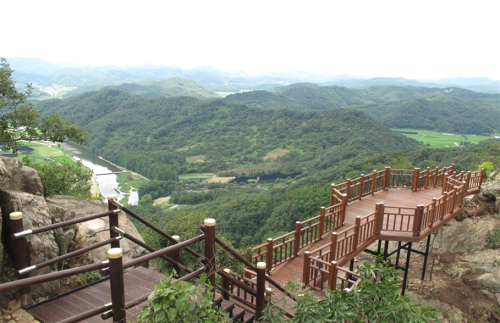 Daejeon Dullesan-gil Trail
Daejeon Dullesan-gil Trail- Around Daejeon
- The mountains extend to surround Daejeon, and in between, the Geumnam Jeongmak (mountain range) meet and merge into Geumgang River. From the view from downtown, with the backdrop of the famous mountain of Geumnam Jung mak, Gyeryongsan Mountain in the west, the Geumsubong Peak and the Dodeokbong Peak connect across Sapjae to Gaphasan Mountain and Wusanbong Peak and extend into Geumbyungsan Mountain in the north. In the east, the ridge of Gyejoksan Mountain extends long and peaks at Sikjangsan Mountain, and in the south it embroiders Bomunsan Mountain and Gubongsan Mountain. It meets the ridges and trails of Bingyesan Mountain, Geumsubong Peak and Dodeokbong Peak. From Sep. 19th, 2004, ‘Connecting Dullesan-gil,’ which is guided hiking, encourages citizens to look around the mountains surrounding Daejeon by connecting many easily discoverable mountains of Daejeon. By hiking mountains surrounding Daejeon in connection, visitors can observe various views of the entire Daejeon city and can naturally realize how beautiful Daejeon is. Also, they can appreciate nature and admire Daejeon! Whenever and wherever you observe the surroundings, the mountains of Daejeon nicely approach the horizon. If we can feel joy by looking at the mountains, we can hold the mountains of Daejeon in our mind as they surround the city! To this end, Daejeon Dullesan-gil trail (133 km) course is divided into 12 parts and is included in a public transportation and trail map and a general information brochure to encourage the citizens to hike easily and comfortably. We hope that many citizens enjoy this so that beautiful mountains will once again return to our people’s minds.
-
 Dongchundang House
Dongchundang House- 80, Dongchundang-ro,Daedeck-gu
- 042-608-6572
- Dongchundang is where the first house built by the ‘Father of Dongchundang’, teacher Jun-gil Song, was moved. Dongchun means to ‘be like lively spring’, and the teacher read books and educated students and created Hyedeok Hyangak (Korean music). As nation-designated cultural property number 209, Dongchundang has a signboard that Wooam Si-yeol Song wrote. The structure is relatively simple and the size is not excessively large. The four sections on the right make up the main floor and the two sections on the left have an ondolbang (Korean heated floor). In front, it is covered with parquet floor boards, and at the bottom of the ondolbang, there are panelboards applied. For the foundation stone, tall squared cornerstone was used and this is a standard form of separate house architecture from the late Joseon dynasty. Behind Dongchundang, there is the old house of Song jun-gil. It is registered as tangible cultural asset number 3 of Daejeon Metropolitan City. The separate ‘Song ssi byul myo’ is a shrine keeping only an ancestral tablet of Jun-gil Song.
-
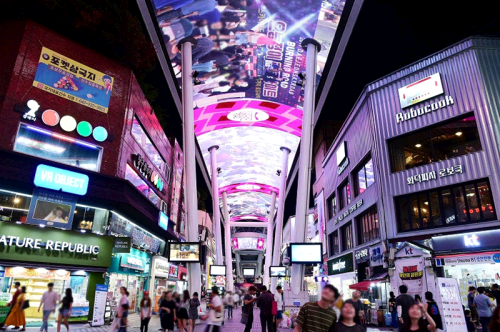 Uineungjeongi Cultural Street
Uineungjeongi Cultural Street- 164, Jungang-ro, Jung-gu Daejeon
- 042-226-9100
- From the 1960s to 1980s, this was a mecca of administration, businesses, and traditional culture in the central region of South Korea. Now it is rising again as a street of Art & Culture. There are over 150 active businesses related to art and culture including art galleries, concert halls, small theaters, exhibition, performance facilities, art supply stores, ateliers, pottery studios, and antique stores. Various festivals including Uineungjeongi festival, Youth maim festival, and the Art and culture street festival take place. In addition, Sky Street that opened in 2013 was built with an arcade-type LED screen equipment with a length of 214 m, width of 13.3 m and height of 20 m. It is a famous tourist attraction in Daejeon and displays a range of content providing both entertainment and publicity using the main screen and media hub.
-
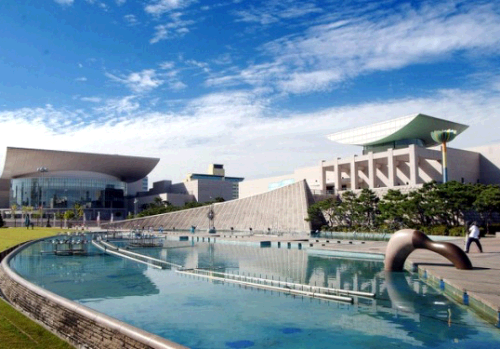 Daejeon Art & Culture Complex
Daejeon Art & Culture Complex- 169, Dunsan-daero, Seo-gu, Daejeon
- Daejeon Art & Culture Complex Art is placed in a culture belt where Daejeon Art & Culture Complex, Daejeon Museum of Art, and Ungno Lee Museum of Art connect. It is a hall with a large size and 1,546 seats and can stage 300 performers. It is a complete cultural art space for grand opera, ballet, musicals, etc. Daejeon Museum of Art adds dignity in sharing a relaxing and reflective lifestyle. Ungno Lee Museum of Art is an art space to study and exhibit artworks of the world-class artist Goam Ungno Lee (1904~1969).
-
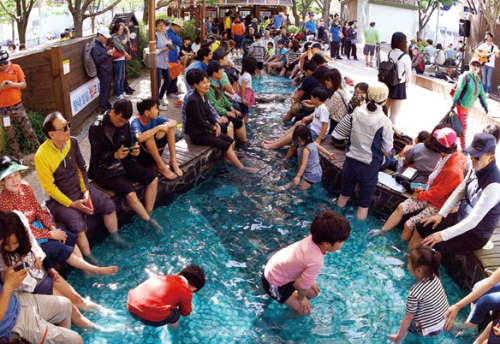 Yuseong Hot Spring
Yuseong Hot Spring- Whole area, Onchenon-ro, Yunseong-gu Daejeon
- At Yuseong Hot Spring Street, Asian Fringe trees with snow-like white petals are planted along the street and the beautiful Snow Flower street is built. It has two foot baths accommodating 80 people with 100% hot spring water pulled up from 200 m underground and maintained at 41 – 43 °C. It also has a waterway. The foot baths are free to access and are popular for tourists as well as local residents even late during the day. Yuseong Hot Spring is the oldest hot spring among 116 in South Korea. It has the highest capacity in South Korea in terms of reservation and usage. It is a weak, basic simple spring that is smooth and gentle to the skin and contains ions, minerals (zinc, iron, etc.) and metallic substances evenly. At the hot spring theme park, there is an outdoor foot bath open to everyone for free. Recently, many visitors have found the foot bath which makes Yuseong Hot Spring livelier.
-
Daejeon O-World
- 70, Sajeonggongwon-ro, Jung-gu
- 042-580-4820
- Daejeon O World is built on 682,830 m2 of blessed nature and is proud to have the largest facility size in the central southern region of S.Korea. It is an integrated theme park comprised of ‘Zoo Land + Flower Land + Joy Land’ that can be enjoyed by an entire family. Here, flower and water-themed individual new gardens and enjoyable scenery with a splendid display of light harmonize and satisfy the five senses of visitors. In a space mixed with about 160 species of 600 animals, themed gardens including Sound Garden, Herb Garden, Rose Garden, etc., and a fountain, also offer various rides including Giant Drop, Flume Ride, and Super Viking. A fun maze made from trees is a space that provides joy to children and couples. Below the maze, a water-themed garden stretches out. Starting with the central pond, a small and cute shallow pond like could be seen in a pastoral town in the past, a cascade known for taking pictures, a circular ground fountain, tunnel fountain, and square ground fountain extend. Likewise, O World is a space with a harmony of nature and eccentric charm from its offerings.
-
 Expo Science Park
Expo Science Park- 70, Daedeokdae-ro, Yuseong-gu, Daedjeon
- 042-601-2500
- It is a science park created to utilize the facilities and grounds after the 1993 Daejeon EXPO as a science education space for citizens. It has many attractions including a simulation theatre, where the chairs move with the movie, electrical energy pavilion and others. At Hanbit Tower, which is the symbolic tower of EXPO Science Park, you can overlook major regions of Daejeon city. The first observatory has a unique knotted circular shape that resembles a space station. Many visitors come to the science park that is a playground of children to develop their imagination. Also, Daejeon EXPO Memorial hall and World EXPO Memorial museum, opened recently, display over 5,000 precious mementos including the world’s first all nations flag scarf from Queen Victoria.

